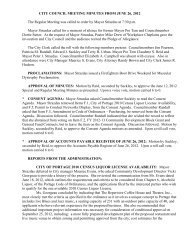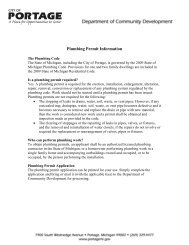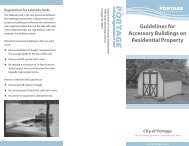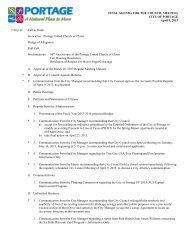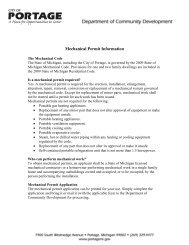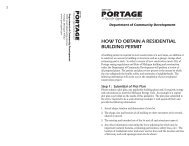Fire Inspection Codes - City of Portage
Fire Inspection Codes - City of Portage
Fire Inspection Codes - City of Portage
You also want an ePaper? Increase the reach of your titles
YUMPU automatically turns print PDFs into web optimized ePapers that Google loves.
INSPECTION REFERENCE<br />
During our annual business inspections, our intent is to assist the business owner /<br />
managers in providing a fire safe establishment. However fire codes can become<br />
somewhat confusing. Below is a list <strong>of</strong> brief descriptions to common fire codes that are<br />
addressed during our inspections. Hopefully these will help before and after our visit.<br />
Should you have any questions or need clarification, please contact the <strong>Fire</strong> Division at<br />
269-329-4487.<br />
BUILDING<br />
1) ADDRESS NUMBERS: Number must be minimum 4" in height, in plain or<br />
legible figures, and in a conspicuous place on the front <strong>of</strong> the building. Color<br />
should be contrasting to color <strong>of</strong> building where attached. The number must be<br />
legible from the street, regardless <strong>of</strong> size <strong>of</strong> letter. Where access is by means <strong>of</strong> a<br />
private road and the building cannot be viewed from the public way, a monument,<br />
pole or other sign or means shall be used to identify the structure. Address may be<br />
on a sign if readily identifiable with building.<br />
2) ADDRESS NUMBERS-REAR: Each occupied tenant space provided with a<br />
secondary exit to the exterior or exit corridor shall be provided with tenant<br />
identification by business name and/or address. Letters and numbers shall be<br />
posted on the corridor side <strong>of</strong> the door, be plainly legible and shall contrast with<br />
their background.<br />
3) AISLES: Aisles shall be not less than 36" wide when serving only one side and<br />
not less than 44' wide when serving both sides. (For example: aisles in seating<br />
areas).<br />
4) ATTIC STORAGE: Attic, under-floor, and concealed spaces used for storage <strong>of</strong><br />
combustible materials shall be protected on the storage side as required for one<br />
hour resistive construction. Openings shall be protected by assemblies that are<br />
self-closing and are <strong>of</strong> non-combustible construction or solid wood core not less<br />
than 1 3/4" in thickness. Storage shall not be placed on exposed joists.<br />
5) CEILING TILES: Tiles must be in place, where installed, to eliminate draft<br />
effects during fire conditions.<br />
6) ELEVATOR KEYS: Keys for the elevator car doors and firefighter service keys<br />
shall be kept in an approved location (elevator mechanical room or Knox Box) for<br />
immediate use by the fire department. A current emergency contact for the<br />
elevator service contractor must be kept in elevator mechanical room.
7) EMERGENCY LIGHTING: Exit illumination shall be provided and maintained for all<br />
buildings. Equipment providing emergency power for exit illumination and exit signs<br />
shall be maintained in an operable condition. If exit signs or emergency lighting are no<br />
longer necessary due to alterations <strong>of</strong> building, the device must be maintained operable or<br />
removed.<br />
8) ENCLOSED STAIRWELLS: Storage is prohibited under exit stairways.<br />
*Exception: Storage is allowed under interior and exterior stairways when such stairways<br />
are not within exit enclosures and such spaces are protected on the enclosed side by one<br />
hour resistive construction as specified in the Building Code.<br />
9) EXIT CORRIDOR: Exit corridors must be maintained and may not be changed unless<br />
approved through a building permit process.<br />
10) EXIT HARDWARE: Exit doors shall be maintained in an operable condition. Doors<br />
having a closure shall bring the door to a latched position. No stops or wedges may be<br />
placed on a door having a closure. Exit doors shall be open-able (operable) from the<br />
inside without the use <strong>of</strong> a key or any special knowledge or effort. When panic hardware<br />
is installed, no other locking device may be used at any time. Double doors must both<br />
remain unlocked during business hours unless directed otherwise by the <strong>Fire</strong> Marshal.<br />
11) EXIT OBSTRUCTED: Obstructions, including storage, shall not be placed in the<br />
required width <strong>of</strong> an exit (44 inches), except projections as allowed by the Building Code<br />
(hand rails, etc.). Exits shall not be obstructed in any manner and shall remain free <strong>of</strong> any<br />
material or matter where its presence would obstruct or render the exit hazardous.<br />
12) EXIT SIGNS: When two or more exits are required for a room or area, exit signs shall<br />
be installed at the required exits from the room or area and where otherwise necessary to<br />
clearly indicate the direction <strong>of</strong> egress. Words on the sign shall be in block letters 6<br />
inches in height. Signs shall be internally or externally illuminated or shall be <strong>of</strong> a selfluminous<br />
type. The premises' wiring system shall provide current power supply to one <strong>of</strong><br />
the lamps. Power to the other lamp shall be from storage batteries or an on-site generator.<br />
13) FIRE DOORS: Doors shall bear an approved label or other identification showing the<br />
rating there<strong>of</strong> and shall be properly repaired, restored or replaced when damaged, altered,<br />
breached, penetrated, removed, or improperly installed, including the label. <strong>Fire</strong><br />
assemblies shall not be obstructed or otherwise impaired from their proper operation at<br />
any time. Horizontal or vertical sliding and rolling doors shall be inspected and tested<br />
annually by the owner or the owner’s authorized representative to check for proper<br />
operation and full closure. A written record shall be maintained and shall be available to<br />
the inspection authority. <strong>Fire</strong> doors having shall have a sign displayed saying<br />
“<strong>Fire</strong> Door – Keep Closed”<br />
14) FIRE LANE SIGNS: Where required by the fire code <strong>of</strong>ficial, approved signs or other<br />
approved notices or markings that include the words NO PARKING—FIRE LANE shall<br />
be provided for fire apparatus access roads to identify such roads or prohibit the<br />
obstruction there<strong>of</strong>. The means by which fire lanes are designated shall be maintained in<br />
a clean and legible condition at all times and shall be replaced or repaired when necessary<br />
to provide adequate visibility.<br />
15) FIRE WALL SEPARATIONS: <strong>Fire</strong> wall separations must be maintained in good<br />
condition, without unprotected penetrations.<br />
16) KNOX BOX: Where access to or within a structure or an area is restricted because <strong>of</strong><br />
secured openings or where immediate access is necessary for life-saving or fire-fighting<br />
purposes, the fire code <strong>of</strong>ficial is authorized to require a key box to be installed in an<br />
approved location. The key box shall be <strong>of</strong> an approved type and shall contain keys to<br />
gain necessary access as required by the fire code <strong>of</strong>ficial. The operator <strong>of</strong> the building<br />
shall immediately notify the fire code <strong>of</strong>ficial and provide the new key when a lock is<br />
changed or rekeyed.
17) OCCUPANT LOAD SIGN: Any room having an occupant load <strong>of</strong> 50 or more where<br />
fixed seats are not installed, and which is used for assembly purposes, shall have the<br />
capacity <strong>of</strong> the room posted in a conspicuous place on an approved sign near the main<br />
exit from the room. Such sign shall indicate the number <strong>of</strong> occupants permitted for each<br />
room use.<br />
18) OPEN STAIRWAYS: No combustible storage is allowed under open stairways.<br />
19) WEEDS, GRASS, BRUSH: Weeds, grass, vines or other growth that is capable <strong>of</strong> being<br />
ignited and endangering property, shall be cut down and removed by the owner or<br />
occupant <strong>of</strong> the premises.<br />
HEATING EQUIPMENT<br />
1) APPLIANCES: Heating appliances shall be installed and maintained in accordance with<br />
their listing and the mechanical code.<br />
2) CLEARANCES: A minimum <strong>of</strong> 36 inches must be maintained around all heat<br />
producing appliances. Any room designed specifically as a furnace room shall have no<br />
combustible storage.<br />
3) PIPES & VALVES, METERS: Above ground gas meters, regulators, and piping<br />
exposed to vehicular damage due to proximity to alleys, driveways or parking areas shall<br />
be protected against such damage.<br />
4) VENTS: Vents and flues must be maintained clean and undamaged.<br />
ELECTRICAL<br />
1) APPLIANCES: Electrical appliances shall be installed and maintained in accordance<br />
with their listing and the electrical code.<br />
2) CLEARANCES: A minimum <strong>of</strong> 36 inches must be maintained around all electrical<br />
equipment, including panels.<br />
3) COVER PLATES: No open switch boxes, junction boxes, or receptacles.<br />
4) ELECTRIC SPACE HEATERS: Portable, electric space heaters shall be plugged<br />
directly into an approved receptacle and must be unplugged when not in use.<br />
5) EXTENSION CORDS: Extension cords shall not be used as a substitute for permanent<br />
wiring. Extension cords shall be used only with portable appliances for the intended<br />
purpose <strong>of</strong> an occasional use. Extension cords shall be plugged directly into an approved<br />
receptacle and shall, except for approved multi-plug extension cords, serve only one<br />
portable appliance. Extension cords shall be maintained in good condition without<br />
splices, deterioration or damage. Extension cords and flexible cords shall not be affixed<br />
to structures; extend through walls, ceilings, floors, under doors or floor coverings, or be<br />
subject to environmental or physical damage.<br />
6) FIXTURES: Fixtures shall be installed and maintained in accordance with their listing<br />
and the electrical code.<br />
7) FUSES/BREAKERS: Fuses and breakers must be labeled as to their use. All spaces in a<br />
breaker panel must be labeled as to their use. All spaces in a breaker panel must be fitted<br />
with a breaker or an approved blank, covering the space. Only approved locks may be<br />
place on breakers – no tape. <strong>Fire</strong> alarm must be on its own circuit and must have an<br />
approved lock on breaker.<br />
8) MULTI-PLUG: Unprotected plug strips, cube adapters and unlisted devices shall not be<br />
used.
9) POWER TAP: Power taps shall not be used as a substitute for permanent wiring. A<br />
power tap (power strip) must be <strong>of</strong> the polarized or grounded type, must have over<br />
current protection, and must be directly connected to a permanently installed receptacle.<br />
10) WIRING: When electrical hazards are encountered, abatement <strong>of</strong> such conditions shall<br />
be taken immediately, if possible. Electrical wiring, devices, appliances and other<br />
equipment which are modified or damaged and constitute an electrical shock or fire<br />
hazard shall not be used.<br />
FIRE PROTECTION EQUIPMENT<br />
1) ALARM SYSTEM: Must be in service at all times and must be serviced by an<br />
authorized company on an annual basis. Records <strong>of</strong> such service must be kept in the<br />
building readily available when requested by fire personnel. <strong>Fire</strong> alarm system must be<br />
maintained and in service or as directed by the <strong>Fire</strong> Marshal in order for occupancy to be<br />
operational.<br />
2) CONTROL VALVES: Must be in service at all times and must be serviced by an<br />
authorized company on an annual basis. Records <strong>of</strong> such service must be kept in the<br />
building readily available when requested by fire personnel.<br />
3) DRY STANDPIPE: Must be clear <strong>of</strong> obstructions, maintained in an operable condition,<br />
and be inspected and serviced per NFPA 25 by a licensed fire protection company.<br />
Records <strong>of</strong> such service must be kept in the building readily available when requested by<br />
fire personnel.<br />
4) FIRE DEPT. CONNECTION: Shall be maintained in an operative condition at all time<br />
and shall be replaced or repaired where defective. Where fire department connections are<br />
subject to impact by a motor vehicle, guard posts or other approved means shall be<br />
installed.<br />
5) FIRE HYDRANTS: Unobstructed access to fire hydrants shall be maintained at all<br />
times. The fire department shall not be deterred or hindered from gaining immediate<br />
access to fire protection equipment or fire hydrants. A 3-foot clear space shall be<br />
maintained around the circumference <strong>of</strong> fire hydrants. Where fire hydrants are subject to<br />
impact by a motor vehicle, guard posts or other approved means shall be installed.<br />
6) FIRE EXTINGUISHERS: Portable fire extinguishers shall be inspected annually in<br />
accordance with NFPA 10. Portable fire extinguishers shall be located in conspicuous<br />
locations where they will be readily accessible and immediately available for use. These<br />
locations shall be along normal paths <strong>of</strong> travel, unless the fire code <strong>of</strong>ficial determines<br />
that the hazard posed indicates the need for placement away from normal paths <strong>of</strong> travel.<br />
Portable fire extinguishers shall not be obstructed or obscured from view. In rooms or<br />
areas in which visual obstruction cannot be completely avoided, signage shall be<br />
provided to indicate the locations <strong>of</strong> extinguishers. Hand-held portable fire extinguishers,<br />
not housed in cabinets, shall be installed on the hangers or brackets supplied. Portable fire<br />
extinguishers having a gross weight not exceeding 40 pounds (18 kg) shall be installed so<br />
that their tops are not more than 5 feet (1524 mm) above the floor and at least 4 inches<br />
between the floor and the bottom <strong>of</strong> the extinguisher.<br />
7) FIXED SYSTEMS: Maintained operable and all maintenance records must be made<br />
available for inspection.<br />
8) IDENTIFICATION SIGNS: <strong>Fire</strong> protection equipment and fire hydrants shall be<br />
clearly identified to easily locate and to prevent obstruction by parking and other<br />
obstructions. Signs must be maintained or replaced.
9) KITCHEN HOODS: Hoods, grease-removal devices, fans, ducts and other<br />
appurtenances shall be inspected at intervals specified in Table 609.3.3.1 or as approved<br />
by the fire code <strong>of</strong>ficial. <strong>Inspection</strong>s shall be completed by qualified individuals. If during<br />
the inspection it is found that hoods, grease-removal devices, fans, ducts or other<br />
appurtenances have an accumulation <strong>of</strong> grease, such components shall be cleaned by a<br />
qualified company or individual or as approved by the fire code <strong>of</strong>ficial.<br />
10) SPRINKLER SYSTEM: Must be clear <strong>of</strong> storage, maintained in an operable condition,<br />
and be inspected per NFPA 25 by a licensed fire protection company. Records <strong>of</strong> such<br />
service must be kept in the building. All suppression systems must also be monitored by<br />
a fire alarm system. <strong>Fire</strong> suppression system must be maintained and in service or as<br />
directed by the <strong>Fire</strong> Marshal in order for occupancy to be operational.<br />
11) WET STAND PIPES/HOSE: Must be clear <strong>of</strong> obstructions, maintained in an operable<br />
condition, and be inspected and serviced per NFPA 25 by a licensed fire protection<br />
company. Records <strong>of</strong> such service must be kept in the building readily available when<br />
requested by fire personnel.<br />
HOUSEKEEPING<br />
1) CEILING AND SPRINKLER HEAD CLEARANCE: Storage shall be maintained 2<br />
feet (610 mm) or more below the ceiling in non-sprinkler areas <strong>of</strong> buildings or a<br />
minimum <strong>of</strong> 18 inches (457 mm) below sprinkler head deflectors in sprinkler areas <strong>of</strong><br />
buildings.<br />
2) CYLINDER STORAGE: Compressed gas containers, cylinders and tanks shall be<br />
secured to prevent falling caused by contact, vibration or seismic activity.<br />
Securing <strong>of</strong> compressed gas containers, cylinders and tanks shall be by one <strong>of</strong> the<br />
following methods:<br />
a. Securing containers, cylinders and tanks to a fixed object with one or more<br />
restraints.<br />
b. Securing containers, cylinders and tanks on a cart or other mobile device designed<br />
for the movement <strong>of</strong> compressed gas containers, cylinders or tanks.<br />
c. Nesting <strong>of</strong> compressed gas containers, cylinders and tanks at container filling or<br />
servicing facilities or in seller’s warehouses not accessible to the public. Nesting<br />
shall be allowed provided the nested containers, cylinders or tanks, if dislodged,<br />
do not obstruct the required means <strong>of</strong> egress.<br />
d. Securing <strong>of</strong> compressed gas containers, cylinders and tanks to or within a rack,<br />
framework, cabinet or similar assembly designed for such use.<br />
Exception: Compressed gas containers, cylinders and tanks in the process <strong>of</strong> examination,<br />
filling, transport or servicing.<br />
3) STORAGE CONTAINER CAPACITY: Containers with a capacity exceeding 5.33<br />
cubic feet (40 gallons) (0.15 m3) shall be provided with lids. Containers and lids shall be<br />
constructed <strong>of</strong> noncombustible materials or <strong>of</strong> combustible materials with a peak rate <strong>of</strong><br />
heat release not exceeding 300 kW/m2 when tested in accordance with ASTM E 1354 at<br />
an incident heat flux <strong>of</strong> 50 kW/m2 in the horizontal orientation. Exception: Wastebaskets<br />
in Group I-3 occupancies shall comply with Section 808.1.
4) STORAGE UNDER OVERHEAD PROJECTIONS: Where buildings are protected by<br />
automatic sprinklers, the outdoor storage, display and handling <strong>of</strong> combustible materials<br />
under eaves, canopies or other projections or overhangs is prohibited except where an<br />
approved automatic sprinklers system is are installed under such eaves, canopies or other<br />
projections or overhangs.<br />
FLAMMABLE LIQUIDS<br />
1) APPROVED CONTAINERS: Only approved containers and portable tanks shall be<br />
used. Containers and portable storage tanks are to be stored in liquid storage cabinets.<br />
2) CONTAINER STORAGE LOCATION: Storage <strong>of</strong> flammable and combustible liquids<br />
inside buildings in containers and portable tanks shall be in accordance with International<br />
<strong>Fire</strong> Code Sections 3404.3.3.1 through 3404.3.3.10.<br />
QUESTIONS BUSINESSES MAY HAVE<br />
Why can’t I mail my responses? While many businesses were are very good about making the<br />
required corrections and mailing back their responses, some businesses either forgot or felt they<br />
had higher priorities. Therefore, a more formal process was needed to insure that needed<br />
corrections were actually made in a timely manner.<br />
Why do I only 20 days to make my corrections? Most corrections are easily made and 20 days<br />
is more than adequate time for the changes. If there are extenuating circumstances that require a<br />
longer time to make the corrections, an extension may be granted.<br />
What would be an example <strong>of</strong> extenuating circumstances? If something needed to be ordered<br />
and didn't arrive; if a contractor was needed to perform work and he was contacted but not yet<br />
finished; both would be examples <strong>of</strong> extenuating circumstances. A good example would be an<br />
inoperable exit sign. An electrician was called and he discovered that the unit was obsolete and<br />
parts were no longer available. This then required replacing the entire sign. A new sign was<br />
ordered but has not yet arrived at the end <strong>of</strong> the 20 day period. This would be an extenuating<br />
circumstance.<br />
If you have an extenuating circumstance, it must be documented. In the above example, just<br />
saying the sign is on order will not be enough. The business should have a copy <strong>of</strong> a work order,<br />
purchase order, or something else to verify the work is actually in progress. The inspectors<br />
should obtain a copy <strong>of</strong> this documentation.<br />
Will I really get a citation? When the firefighters return to do a follow-up inspection, citations<br />
will be issued for any remaining violations that are still uncorrected unless the inspector finds<br />
extenuating circumstances as described above. Of course, if all violations are corrected, no<br />
citations will be issued.<br />
What happens if I get a citation? Violations <strong>of</strong> the <strong>Fire</strong> Code are civil infractions, just like<br />
traffic tickets. If a citation is issued, it will look like a traffic ticket and will be handled in much<br />
the same way. Within 10 calendar days, the business must contact the 8th District Court<br />
Magistrate, located at 150 E. Crosstown Pkwy, Kalamazoo, Michigan. This can be done by<br />
telephone (the number is on the ticket) or in person. The Magistrate will indicate the amount <strong>of</strong><br />
the fine and it can be sent to the Court in the same manner that traffic tickets are paid. Also, just<br />
like traffic tickets, there are procedures for businesses who want to challenge the citation.
Even though a citation has been issued, the violation still needs to be corrected. Therefore, the<br />
<strong>Fire</strong> Marshal will be out for an additional follow-up after five business days from the issuance <strong>of</strong><br />
the citation to insure this has been done. If so, all is fine. If the violation still exists, an additional<br />
citation, with a higher resulting fine, will be written and an additional follow-up by the <strong>Fire</strong><br />
Marshal will occur. The visit by the <strong>Fire</strong> Marshal and/or designee for the third inspection will<br />
result in a re-inspection fee, as provided by a resolution <strong>of</strong> the <strong>City</strong> Council. Any citations not<br />
properly addressed in a timely fashion will result in a bench warrant for the owner and/or<br />
occupant <strong>of</strong> the business.<br />
When you come back to make the re-inspection, that is harassment. The re-inspection visit is<br />
extremely focused and should not take more than a few minutes. We will only be looking to see<br />
if the previously identified violations have been fixed. Once that is done, we will be gone.<br />
However, should an immediate life safety hazard be observed, it will be dealt with accordingly.<br />
Why can’t I make an appointment for a re-inspection? The <strong>Fire</strong> Department is an emergency<br />
service. <strong>Fire</strong> inspections are worked in around emergency requests for service and my not occur<br />
exactly when planned. Many variables impact the ability <strong>of</strong> the <strong>Fire</strong> Department to adhere to a<br />
strict inspection schedule. This makes scheduling appointments impractical.<br />
This is a bad time for me, can you come back later? Inspecting firefighters must use their<br />
discretion and common sense in a situation like this. It may be a bad time for a restaurant when<br />
they are busy and full <strong>of</strong> people and this may be the best time to inspect to insure that exits aren't<br />
blocked, capacities exceed and other issues that result from a busy scene. On the other hand, a<br />
visit to a veterinarian's <strong>of</strong>fice when the doctor is doing surgery may not be the best time because<br />
the doctor could not accompany the inspectors and the operating room may be unavailable to<br />
inspect. In some instances, it may be better to come back and in some, it may be better to stay. In<br />
all cases, we need to explain what we are doing and why, and make it clear that we are not there<br />
to simply harass the business. It is not the intent <strong>of</strong> the firefighters and/or inspectors to cause any<br />
undue hardship on the occupant when it comes to a fire inspection. The firefighters and<br />
inspectors try to perform inspections outside <strong>of</strong> the “normal” busy times for a business.<br />
Although every effort is made to work with the building occupant on a convenient time for the<br />
inspection, this is not always possible. A building owner/occupant does not have the authority to<br />
deny entry to fire personnel and must make necessary accommodations in order to accomplish<br />
the fire inspection should that be required.<br />
Where can I get my fire extinguisher serviced (or something similar)? Explain that several<br />
qualified providers <strong>of</strong> the required service can be found in the Yellow Pages, in the newspaper,<br />
on the internet, or other sources. The <strong>Fire</strong> Department cannot be in the business <strong>of</strong> suggesting or<br />
recommending one business over another. Several vendors that could provide this service can be<br />
found in the yellow pages under the heading <strong>of</strong> “fire extinguisher.”
MAKING THE GRADE:<br />
A GUIDE TO FIRE INSPECTIONS IN THE CITY OF PORTAGE<br />
The <strong>City</strong> <strong>of</strong> <strong>Portage</strong> has adopted the International <strong>Fire</strong> Code. In an effort to prevent fires,<br />
members <strong>of</strong> the <strong>Portage</strong> <strong>Fire</strong> Department conduct annual inspections <strong>of</strong> retail, commercial,<br />
industrial and multi-family residential properties to insure compliance with code provisions.<br />
<strong>Inspection</strong>s, during business hours, are unannounced. A representative <strong>of</strong> the business being<br />
inspected is invited and encouraged to accompany the inspectors on their rounds. Many<br />
violations can be corrected immediately and others can be explained during this visit.<br />
Hazards determined to be an immediate threat to life and health must be corrected immediately.<br />
Inspectors have the authority to close a business if this is not done. Other violations that are not<br />
an immediate threat are required to be corrected within twenty days and the firefighters will<br />
make a return visit to insure any violations have been corrected. While it is the goal <strong>of</strong> the <strong>Fire</strong><br />
Department to educate business operators on fire prevention and safety and achieve voluntary<br />
compliance with provisions <strong>of</strong> the International <strong>Fire</strong> Code, civil citations will be issued for<br />
repeated or uncorrected violations.<br />
PREPARING FOR YOUR INSPECTION<br />
There are several things you can do to prepare for fire inspections including practicing good<br />
housekeeping and making fire prevention a priority among your employees. Many <strong>of</strong> the<br />
violations found in <strong>Portage</strong> fall into several main areas and can be prevented with some selfinspecting<br />
and follow-up.<br />
Blocked Exits: Items shall not be placed in front <strong>of</strong> fire exits or in aisles leading to exits.<br />
This includes chairs and tables, boxes, and other items. <strong>Fire</strong> exits shall be unlocked while<br />
the location is occupied or shall be equipped with approved panic hardware.<br />
Exit Signs: If you are required to have exit signs in rooms or buildings, the block letters<br />
must be at least 6 inches high. They must be in a contrasting color with the background.<br />
These signs must be internally or externally illuminated for easy viewing. Power to one<br />
lamp will come from the main building power supply. The other light must get power<br />
from batteries or an on-site generator. If you use batteries, check them regularly to insure<br />
that they are charged and operating.<br />
Emergency Lighting: You are required to have emergency lighting for a1l fire exits.<br />
These must work when the regular power is out. Again, if you use batteries, check them<br />
regularly to insure that they are charged and operating.<br />
Ceiling Tiles: If you have ceiling tiles, they must be in place and openings cannot be<br />
present. If a fire were to start, missing tiles could create draft conditions that could cause<br />
the fire to spread more rapidly.<br />
Heat Producing Clearances: All heat producing appliances must have at least 36 inches<br />
<strong>of</strong> clearance around them. This includes heaters but also includes cooking equipment.<br />
Any room designed specifically as a furnace room cannot be used for storage <strong>of</strong><br />
combustible items.<br />
Extension Cords: Extension cords cannot be used as a substitute for permanent wiring.<br />
If you make a change that requires permanent wiring, it must be installed. Extension<br />
cords can be used only for portable appliances and only if they are used correctly. The<br />
cords must be maintained in good condition. Extension cords cannot be fixed to walls,<br />
floors or ceilings and they cannot extend through walls, ceilings. floors, under doors or<br />
floor coverings and be used where they can receive environmental <strong>of</strong> physical damage. If
an extension cord is used under these approved conditions, it must be plugged into an<br />
approved receptacle or multi-plug adopter. Questions about approved uses <strong>of</strong> extension<br />
cords can be answered by calling the <strong>Fire</strong> Prevention Office.<br />
Multi-Plug Strips: Any use <strong>of</strong> multi-plug strips, such as computer surge protectors, must<br />
be UL approved and must be protected by an internal circuit breaker.<br />
Cover Plates: All electrical switches, receptacles (plugs), and junction boxes must be<br />
covered so that wires are not exposed.<br />
Electrical Clearances: A three-foot clearance must be provided around all electrical<br />
equipment including electrical panels (fuse boxes).<br />
Portable <strong>Fire</strong> Extinguishers: Portable fire extinguishers must be inspected and serviced<br />
once a year by a company that provides this service. Several companies are listed in the<br />
telephone directory that will provide this service, <strong>of</strong>ten on an annual contract. These<br />
companies can also insure that that the extinguishers are mounted correctly and are ready<br />
for use. Each extinguisher needs an inspection tag that indicates that someone in your<br />
business has looked at the extinguisher monthly to insure that it is charged.<br />
Ceiling Clearances: If you do not have fire sprinklers, nothing may be stored within two<br />
feet <strong>of</strong> the ceiling. If you do have sprinklers, storage must be at least 18 inches below the<br />
sprinkler heads.<br />
Equipment Rooms: Combustible material cannot be stored in boiler rooms, mechanical<br />
rooms or electrical equipment rooms.<br />
Cylinder Storage: If you use compressed gas cylinders they must be secured with one or<br />
more restraints to a fixed object such as a wall. This is to prevent them from falling and<br />
releasing their pressurized contents. If you use portable cylinders or large numbers <strong>of</strong><br />
large cylinders, some special conditions apply. The <strong>Fire</strong> Marshal will be happy to review<br />
these conditions with you if necessary.<br />
These are some <strong>of</strong> the violations <strong>of</strong> the International <strong>Fire</strong> Code that are typically found. This is<br />
not an all-encompassing list <strong>of</strong> provisions that must be followed but only a guide to assist you. If<br />
you have specific questions about your location, please contact the <strong>Fire</strong> Marshal.<br />
GENERAL GUIDELINES<br />
Many fires are caused by smoking materials. If your business allows smoking, you<br />
should designate smoking areas and insure that smoking materials are disposed <strong>of</strong><br />
properly. Post NO SMOKING signs in areas with flammable liquids or other hazards.<br />
Check electrical appliances for proper operation. Pay particular attention to the condition<br />
<strong>of</strong> the cord.<br />
Housekeeping is important. Keep work areas free from accumulation <strong>of</strong> combustible<br />
materials. Keep dumpsters and trash cans closed. Make sure dumpsters are away from<br />
building openings and not under building overhangs.<br />
Check heating systems regularly.<br />
If you have fire doors, be sure they are maintained. Be sure doors with panic hardware<br />
are not secured with dead-bolts, chains, or other locking devices.<br />
Promptly fix holes in ceilings or walls to prevent spread if a fire does start.<br />
*Disclaimer: This brochure is prepared as a guide to common problems only and is not to be<br />
considered legally binding or a direct quotation <strong>of</strong> the International <strong>Fire</strong> Code.



